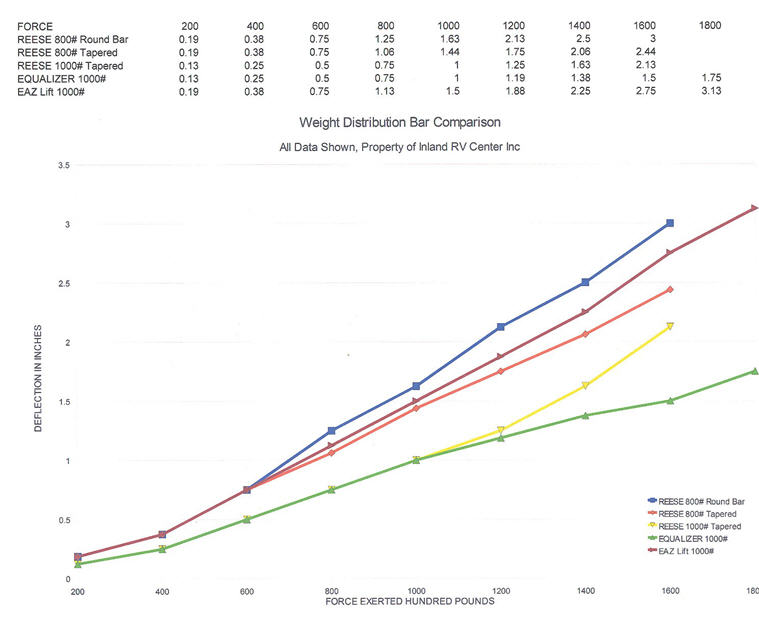- Home
- Historical & Research
- The Hitch Torsion Bar Story
The Hitch Torsion Bar Story
- By Andy Rogozinski
- Published 10/23/2011
- Historical & Research
 Andy Rogozinski
Andy Rogozinski

Since 1966 Airstream enthusiasts, movie stars and film crews have depended on Inland RV Center for renovations, expertise, creativity and innovation.
View all articles by Andy Rogozinski
Load equalizing hitch or torsion bars are designed to transfer travel trailer tongue weight back to the trailer axle or axles, as well as transferring some of the trunk weight or rear end weight of the tow vehicle to the front axle of the tow vehicle.
Typically, 60 percent of the tongue weight goes to the tow vehicle and 40 percent goes back to the trailer axle or axles with properly rated, properly installed and properly adjusted torsion bars.
Torsion bars have different ratings so that they can properly match the tongue weight to a specific tow vehicle. Generally the heavier duty the tow vehicle, the lighter duty the tow bars should be so that a soft ride can be provided for the Airstream. Different rating bars should be used for different types of tow vehicles for the same trailer tongue weight.
Heavier duty bars used with heavy duty tow vehicles transfer considerably more road shock to the front of the trailer. That can and often does cause a variety of damage to the trailer. It causes fatigue cracks in the frame and sheet metal, causes rear end separation, wears out the entrance door hinges, shears rivets and creates water leaks. It may also open closet doors, throw clothes off hangers, open drawers and generally rearrange whatever might be inside the trailer. There are several different type of hitch torsion bars available in different ratings and shapes. There are square, round and tapered bars.
We tested different shaped bars made by Reese, Eazlift and Equalizer. A hitch box receiver was used that could not move. We inserted different ball mounts to match the respective torsion bars. A sensitive scale was used that had a chisel point edge. This edge was placed underneath the bars all at the same distance from the pivot point at the ball mount and was lifted by a floor jack to increase the stress on the torsion bars.
CONCLUSIONS (see graph below): Round bars do not offer any significant difference in stiffness or softness compared to tapered bars. Reese dual cam sway controls unequally increases the bend in the torsion bars when a turn is made, further increasing the torsion, which advances the sway control to return the rig to a straight line.
True friction-type sway controls offer resistance when turning and the same resistance returning to a straight line. The Equalizer bars offered the least bend for a given weight, making it the stiffest torsion bar tested. That in turn transfers the most shock of all the torsion bars tested.

Andy Rogozinski
Inland RV Center, Inc.
www.inlandrv.com
Typically, 60 percent of the tongue weight goes to the tow vehicle and 40 percent goes back to the trailer axle or axles with properly rated, properly installed and properly adjusted torsion bars.
Torsion bars have different ratings so that they can properly match the tongue weight to a specific tow vehicle. Generally the heavier duty the tow vehicle, the lighter duty the tow bars should be so that a soft ride can be provided for the Airstream. Different rating bars should be used for different types of tow vehicles for the same trailer tongue weight.
Heavier duty bars used with heavy duty tow vehicles transfer considerably more road shock to the front of the trailer. That can and often does cause a variety of damage to the trailer. It causes fatigue cracks in the frame and sheet metal, causes rear end separation, wears out the entrance door hinges, shears rivets and creates water leaks. It may also open closet doors, throw clothes off hangers, open drawers and generally rearrange whatever might be inside the trailer. There are several different type of hitch torsion bars available in different ratings and shapes. There are square, round and tapered bars.
We tested different shaped bars made by Reese, Eazlift and Equalizer. A hitch box receiver was used that could not move. We inserted different ball mounts to match the respective torsion bars. A sensitive scale was used that had a chisel point edge. This edge was placed underneath the bars all at the same distance from the pivot point at the ball mount and was lifted by a floor jack to increase the stress on the torsion bars.
CONCLUSIONS (see graph below): Round bars do not offer any significant difference in stiffness or softness compared to tapered bars. Reese dual cam sway controls unequally increases the bend in the torsion bars when a turn is made, further increasing the torsion, which advances the sway control to return the rig to a straight line.
True friction-type sway controls offer resistance when turning and the same resistance returning to a straight line. The Equalizer bars offered the least bend for a given weight, making it the stiffest torsion bar tested. That in turn transfers the most shock of all the torsion bars tested.

Andy Rogozinski
Inland RV Center, Inc.
www.inlandrv.com
